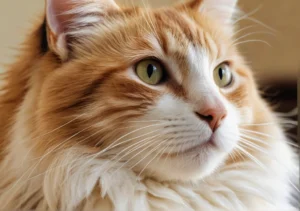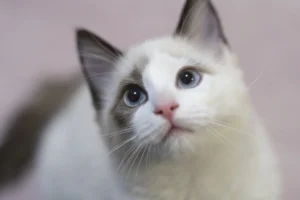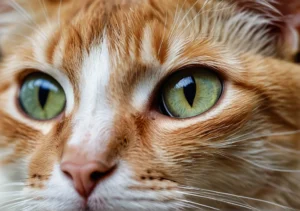Have you ever noticed that cats’ eyes are often a striking shade of black? It’s a common trait among our feline friends, but have you ever wondered why this is the case?
Cats have black eyes due to a high concentration of melanin in their iris, which absorbs more light and gives them better vision in low light conditions. Let’s explore the fascinating reasons behind why cats’ eyes are black.
The Role of Melanin in Cats’ Eyes
Melanin, the pigment responsible for giving color to our skin, hair, and eyes, plays a crucial role in determining the color of cats’ eyes as well. In the case of black eyes in cats, melanin is produced in higher concentrations in the iris, the colored part of the eye. This abundance of melanin absorbs more light, preventing it from reflecting back out, thus resulting in the black hue that we see in their eyes.
Melanin not only determines the eye color but also serves a vital function in protecting the eyes from harmful UV rays. Melanin helps in filtering out excessive light and reducing the risk of damage to the sensitive structures within the eye, such as the retina. So, while black eyes may seem mysterious and captivating, they are also a product of nature’s ingenious way of safeguarding our feline friends’ vision.
Evolutionary Advantages of Black Eyes in Cats
Having black eyes provides cats with significant evolutionary benefits, especially when it comes to hunting and survival. The dark pigmentation of their eyes aids in enhancing their night vision, allowing them to see more clearly in low light conditions. This advantage gives them an edge when stalking prey during dusk or dawn when their natural prey is most active.
Moreover, black eyes help cats to camouflage better in the dark, making it easier for them to remain unseen by potential predators or prey. This stealthiness is crucial for their survival in the wild, where staying hidden can mean the difference between catching a meal and becoming one.
In addition to improved night vision and camouflage, the black eyes of cats also contribute to their overall intimidating appearance, deterring potential threats and asserting dominance in their territory. This combination of enhanced vision, camouflage, and intimidation factor makes black eyes a valuable asset for cats, ensuring their success in the wild.
Variations in Cats’ Eye Color
Cats come in a variety of eye colors, from striking green, blue, amber, and yellow to deep, mysterious black. These eye colors are determined by the amount of melanin present in the iris. The more melanin a cat has, the darker their eyes will appear. Cats with black eyes have a high concentration of melanin in their irises, giving them that intense black color. On the other hand, cats with lighter eye colors have less melanin, resulting in hues like green or blue. Melanin is like the paint that gives cats their eye color palette, with black being the result of a rich, dark pigment concentration.
The Mystery of Cat Eye Shine
Have you ever noticed the mesmerizing shine in a cat’s eyes, especially in low light? This captivating phenomenon is known as eye shine, and it’s closely related to the black color of their eyes. Cats have a special reflective layer behind their retinas called the tapetum lucidum. This layer acts like a mirror, reflecting light that enters the eye back through the retina, enhancing their night vision. The tapetum lucidum also contributes to the appearance of cat eye shine, giving their eyes that enchanting glow in the dark. So, when you see those eerily beautiful black eyes gleaming in the night, you can thank the tapetum lucidum for adding to the mystique of your feline friend.
Health Considerations Related to Cats’ Eye Color
When it comes to the color of your cat’s eyes, it can actually provide some valuable insights into their health. Dark or black eyes in cats are typically a sign of good health and normal vision. However, sudden changes in eye color, such as a cat’s eyes turning red or yellow, could be a sign of an underlying health issue and should be promptly addressed by a veterinarian.
Cats with light-colored eyes, like blue or green, may be more prone to certain eye conditions such as cataracts or iris melanoma. It’s essential to monitor any changes in your cat’s eye color and seek veterinary advice if you notice anything unusual.
Remember, regular check-ups with your vet can help ensure your cat’s eyes stay healthy and beautiful for years to come.
Cat Eye Color Myths Debunked
Let’s debunk some common myths surrounding the color of cats’ eyes. Contrary to popular belief, not all black cats have black eyes. Black cats can have a range of eye colors, including amber, green, or gold. Additionally, the idea that all cats with blue eyes are deaf is a misconception. While some cats with blue eyes may be deaf, it’s not a blanket rule that applies to all cats with this eye color.
Another myth to dispel is the belief that all cats with yellow eyes are aggressive. Just like humans, cats’ personalities are not solely determined by their eye color. Each cat is unique and should be judged based on their individual behavior, not the hue of their eyes.
Remember, when it comes to cat eye color, there is a wide range of natural variation, and each cat is special in their own way.
Fun Facts About Cats’ Eyes
Cats’ eyes have a layer called the tapetum lucidum, which reflects light and helps them see well in low light conditions, giving them that spooky glowing effect in the dark. This unique feature also enhances their night vision, making them excellent hunters under the moonlight.
Cats have a wider field of vision than humans, around 200 degrees compared to our 180 degrees. This panoramic view, combined with their ability to see in dim light, contributes to their prowess as stealthy predators.
A cat’s eye color can change as they age. Kittens are typically born with blue eyes, which may change to a different color as they mature. Some cats even have two different colored eyes, a condition known as heterochromia, which adds to their mystique and charm.
The Connection Between Cats’ Eyes and Personality
According to popular beliefs and folklore, there is a widespread belief that a cat’s eye color can reflect its personality traits. While there isn’t scientific evidence to support this notion, many people associate specific characteristics with different eye colors.
Black cats are often associated with mystery, elegance, and intelligence. Their sleek black fur and piercing black eyes have been linked to qualities like independence, determination, and a touch of mischief. These feline companions are often seen as enigmatic and enchanting creatures.
On the other hand, cats with vibrant green or yellow eyes are thought to be more lively, playful, and energetic. Their bright gaze is often seen as a reflection of their spirited and curious nature. Whether your cat’s eyes are black, green, blue, or any other color, each feline friend is unique and special in their own way.
Extra tip: Remember that each cat is a unique individual, so while eye color may add to their charm, it’s essential to appreciate them for their individual personalities and quirks.
The Intriguing World of Cat Vision
Have you ever wondered why cats’ eyes are usually black? Well, it’s not just a random color choice! The black pigment in a cat’s eyes, specifically in the iris, actually serves a crucial purpose. Unlike humans, who have a wide range of colors in their irises, cats have black irises because they have a vertical-slit pupil that can dilate significantly in low light conditions. This allows them to see clearly in the dark and hunt effectively.
Cats possess excellent night vision due to a high number of rod cells in their retinas, which are sensitive to low light. The black pigment in their eyes enhances this ability by preventing light from reflecting off their irises, thus minimizing glare and allowing more light to enter their eyes for improved vision in dimly lit environments. So, next time you see a cat with those mysterious black eyes, remember that it’s all about optimizing their vision for their nocturnal hunting instincts.
Caring for Cats’ Eyes
Taking care of your feline friend’s eyes is crucial for their overall health and well-being. While cats are known for being self-sufficient creatures, they still need a little help in maintaining their eye health. Here are some tips to ensure your cat’s eyes stay bright and healthy:
- Regularly wipe away any discharge: Cats can sometimes have discharge in the corners of their eyes, which should be gently wiped away with a damp cloth to prevent irritation or infection.
- Monitor for any changes in eye appearance: Keep an eye out for any redness, swelling, cloudiness, or changes in your cat’s eye color, as these could be signs of an underlying health issue.
- Trim long fur around the eyes: Long fur around the eyes can cause irritation and lead to eye problems. Make sure to keep it trimmed short to prevent any issues.
- Visit the vet: Regular check-ups with a veterinarian can help catch any eye problems early on and ensure your cat’s eyes are in top shape.
By following these simple tips, you can help keep your cat’s eyes healthy and happy, allowing them to see the world clearly and enjoy their days to the fullest.
The Unique Charm of Cats’ Eyes
Cats’ eyes are truly captivating, with their unique black color adding to their mysterious allure. Unlike humans, who have a variety of eye colors, from blue to green to brown, cats predominantly have black eyes. This is due to a high concentration of melanin, the pigment that gives color to the eyes.
The deep black hue of a cat’s eyes enhances their ability to see in low light conditions, making them excellent hunters even in the dark. This adaptation is a significant advantage for cats, allowing them to navigate their surroundings with ease and precision, whether they are prowling for prey or simply exploring their territory.
As pet owners and animal lovers, we are drawn to the enchanting gaze of cats’ eyes. Their intense, soulful stare can communicate a range of emotions, from affection to curiosity to contentment. It is no wonder that cats’ eyes have been the subject of admiration and inspiration for artists, poets, and writers throughout history.
Next time you catch a glimpse of your feline friend’s mesmerizing black eyes, take a moment to appreciate the beauty and uniqueness they bring to your life. Embrace the magic of cats’ eyes and the special connection they create between humans and our beloved furry companions.
The Adaptive Advantage of Black Eyes
In the animal kingdom, eye color can serve as more than just a cosmetic feature. For cats, the black color of their eyes is not only striking but also serves a practical purpose. The high concentration of melanin in their eyes helps protect them from harmful UV rays and enhances their vision in low light conditions.
The evolution of black eyes in cats is a fascinating example of adaptation to their environment. From their wild ancestors to modern domesticated felines, cats have developed this trait to excel in their role as skilled predators. The black hue of their eyes allows them to focus intensely, track their prey with precision, and move stealthily in the shadows.
So, the next time you look into your cat’s deep black eyes, remember that this striking feature is not just for show—it is a key component of their survival and hunting prowess. Appreciate the beauty and functionality of your cat’s eyes, and marvel at the wonders of nature’s design.
Alex, a passionate animal lover, has experience in training and understanding animal behavior. As a proud pet parent to two dogs and three cats, he founded AnimalReport.net to share insights from animal experts and expand his knowledge of the animal kingdom.




